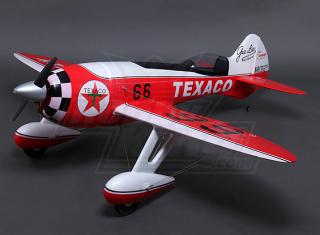Durafly Monocoupe
Wingspan: 1100mm
Format: 4 ch/4 servo Highwing monoplane with fixed gear and steerable tail wheel
Equipment used (not supplied): Spektrun DX6i and AR6210 receiver with satellite, Nanotech 3S 2200 battery, low voltage buzzer.
Source: Hobbyking
Location: Southern Fun Fliers lot, Tasmania
Condition: westerly wind, less that 5 kn. Partially cloudy (on the day of the maiden. Really weird puffy gusts and overcast on the 2nd day of flying)
Assembly: Went by the book, with no nasty surprises relating to fit or missing items, but with two notable points: Firstly, the factory installed ESC was not properly plugged into the motor, and the esthetic flying wires for the tail plane proved just too fiddly, trying to knot a thin rubber cord around tiny expansion spring that does not have closed eyes. After about an hour trying to get one knot tied, they were discarded.
With the recommended battery, the model CG'ed fine (unlike most other HK planes that I have personally encountered), but the included prop is heavy, thick plastic and has a noticeable effect on static CG. Extra weighting would be required if it was swapped out for an APC or MA unit. There is ample room for this, along with a low voltage alarm in the battery compartment.
Maiden: With all control surfaces mechanically trimmed straight during assembly, the first flight was a pleasant experience. Rolling up to 2/3rds throttle saw a cilivised accent, with only a mild amount of elevator required to set the model's intent.
When airborne, the Monocoupe flew dead level without further trimming. It appeared to sitting tail low, until I realised it was an optical illusion created by the concave curve of the fuse's profile.
The model is happy to cruise at 2/3rds to 3/4 throttle. Any more and there's no noticeable increase in speed, it just gets louder. Which, I should mention, is not a bad thing. Probably due to the reasonable density of the foam, this plane emits a pleasant deep throbby noise, kind of like an electrical foam model impersonation of what you'd expect of the original racer. It will fly happily down to about 1/3rd stick, but you have to be much more active on the controls to maintain a level altitude at this point, you are very much sliding off the envelope.
However, at the mid or above throttle point, the Monocoupe loves long turns, banked well up. I found that most of the time little to no elevator was needed to maintain altitude during these long banked turns. However, on occasions a jab of up was required to keep things level, which I attributed to strange little puffs of wind that we were experiencing that day, as this would occur as the plane was crossing the direction of the breeze (although I am no expert on the matter, just a hunch). This did not inspire me to try any silliness, even though HK promote this model as an entry to aerobatics. I will note, on a later flight on another (less than perfect) day, I had a gust catch the plane and near flip it out of the bank and turn it 90 degrees into the wind in a split second. Uninvited, but not disastrous.
Landings were consistently not bad at all. Even with the envelope tapering off higher than I am used to with my beginner models, I still managed to line up and settle down safely. On one occasion, wind was driving my landing leg too far to a side I didn't want to be on, so I chopped and dropped from about a meter, rather than a foot to get it down quickly. The semi suspended main gear just soaked it up, a bit of a rebound and all was fine. It seems quite robust in this area. A good thing.
All in all, I think I described the experience as "Flying an EK Holden", and not in a bad way. The Monocoupe certainly feels how it looks, and from someone who likes things scale, I has a happy and I'm looking forward to taking it up again.











 paaaaaatience
paaaaaatience  paaaaaaatieeence
paaaaaaatieeence  dooooohhhh !!!
dooooohhhh !!! 
 )
)
